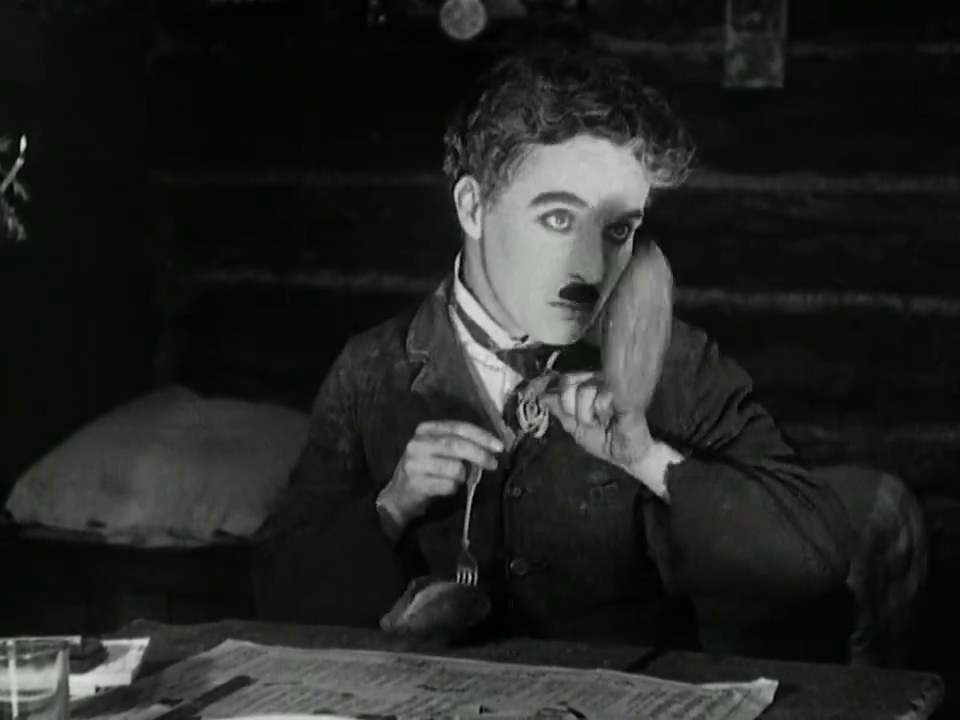A Century of Film is Devin Wilger’s attempt to watch a movie from every year between 1917 and today. This time, it’s 1925 - sort of - with The Gold Rush.
There were three silent comedians that stand out among the rest. One, Harold Lloyd, we have covered already. Two, Buster Keaton, who we will cover in the future. Three, Charlie Chaplin, who we will cover today, with The Gold Rush, the film he wanted to be remembered for making.
Chaplin’s comedy was very much driven by character. Lloyd, for example, was driven by the gag, but his character wasn’t very unique - it was just a guy in glasses with bad luck. That’s fine, because Lloyd had great gags. Chaplin’s gags are also great - the tilting cabin finale here is fantastic - but he’s also much more concerned with how the character reacts to the gag rather than the gag itself. The Gold Rush’s best moments are all about how characters react and move, even if the setup isn’t inherently funny he still mines comedy out of the reaction - one gets the impression that he could get a good comedy bit out of anything. The opening scene, for example, has Chaplin’s lone prospector walk across the screen, that’s it. There’s nothing inherently funny about the set, or what Chaplin has to do - in the hands of someone else, it’s just an establishing shot. But because Chaplin has him walk in an amusing and oblivious way, it’s a comic setpiece. The most famous scene in the film, the bread roll dance, is a dance involving bread rolls stuck to forks, a scene that only works because Chaplin has the ability to make even the tiniest movement funny.
The plot here isn’t that important. Chaplin is a somewhat inept gold miner. Big Jim McKay (Mack Swain) is a very good gold miner. Black Larsen (Tom Murray) is a bad man. Due to a winter storm they all stay in a shack together and almost starve. Then, after the storm, Larsen tries to steal McKay’s gold and hits him on the head in the process, while Chaplin’s character returns to town and falls in love with a dancing girl named Georgia (Georgia Hale) who initially thinks herself too good for him but slowly falls in love. The plot is kind of a thin thread to connect the film, though the love story allows Chaplin to add a bit of sadness to the picture - something he started doing way back in his early shorts, it grounds the characters and makes them more appealing to the audience, Chaplin standing in a doorway searching for his love interest is quietly heartbreaking.
The film is like the cabin in the big finale, on the very edge of becoming something very serious, with only a bit of flailing stopping it from going over the end of the dramatic mountain. Characters almost starve to death, but that leads to the comedy of them eating a boot or Chaplin turning into a giant chicken in front of his companion - I don’t know if this is the first case of this happening, but it did become a staple of cartoons. Chaplin’s chicken-like movements while a person are so perfect they sell the chicken half of the gag. Characters are complex, and Chaplin uses that complexity as the base of most of the gags, everything works better because of how his characters respond. It’s a comedy where it feels as though the characters have an inner life, and that is best realized through how they react to absurd situations Chaplin throws at them.
I will confess that the version of The Gold Rush that graced my television screen was not the original 1925 version. Instead, it was Chaplin’s re-release from 1942. Since Chaplin was the writer, director and star of the original film - and did the music and narration in the modified version - it’s not like it was someone coming in after the fact and changing his artistic vision. But it could be considered of the same school as George Lucas’ Star Wars Special Editions, a new version that uses newer technology to do things that they couldn’t do the first time around. Lots of people hate those Special Editions, and to be honest the revised version of The Gold Rush is a bit more awkward than the original would have been.
This is the Gold Rush with sync sound, the title cards are swapped out for a narrator, there are a few sound effects added, and Chaplin does a new soundtrack. The soundtrack is good, the sound effects are effective. The narration isn’t bad so much as there is just so much of it, ironically for a silent film legend Chaplin will not stop talking. It sometimes serves as a distraction, since it was originally designed to play without it and the sound feels as though it’s stepping on the toes of the actors. That’s the general problem with a re-release that modernizes the special effects, even though their heart is in the right place you know that wasn’t an original part of the scene, so it feels very stitched on after the fact. I can understand why filmmakers want to do these updates, but they always feel tacked on after the fact, and rarely enhance the original.
Sound or no sound, The Gold Rush is a pretty good summary of why Chaplin matters. He’s a comedian who built his world around characters, and his greatest achievement each time was making characters the audience immediately understood - more than liked or disliked, but felt they could relate to and whose actions made sense. No wonder he wanted it to be the film people remembered.
Next time, the most powerful woman in silent Hollywood, Mary Pickford, with Sparrows.



